
French postcard. Jules Verne.

Romanian postcard by Editura Librariei SOCEC & Co. S.A., Bucuresti. Photo: Monopol "Lux-Film". Ivan Mozzhkukhin in Michel Strogoff (Victor Tourjansky, 1926).
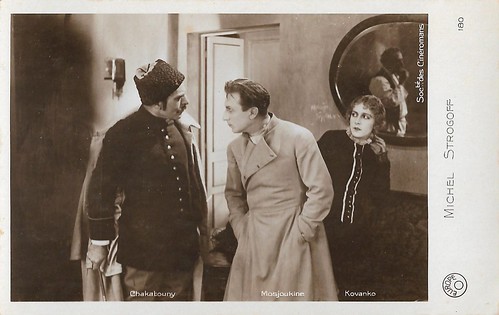
French postcard by Europe, no. 180. Photo: Société des Cinéromans. Ivan Mozzhukhin, Nathalie Kovanko and Acho Chakatouny in Michel Strogoff (Victor Tourjansky, 1926), based on Jules Verne's classic novel.

French postcard by Les Productions J.N. Ermolieff / Tobis. Adolf Wohlbrück in Michel Strogoff (Jacques de Baroncelli, Richard Eichberg, 1936), based on the novel by Jules Verne.

Italian postcard. Photo: Dear Film. Ursula Andress and Jean-Paul Belmondo in Les tribulations d'un Chinois en Chine/Up to His Ears (Philippe de Broca, 1965), based on the novel by Jules Verne from 1878.
Five Weeks in a Balloon
Jules Gabriel Verne was born in 1929 in Nantes, France. He was the eldest of five children of Pierre Verne, a Parisian lawyer from a family of lawyers, and Sophie Allotte de la Fuÿe. His father wanted Jules to succeed him, but Jules' heart was set on the sea.
The story that Verne only travelled in his stories is untrue. He made a train journey to Scotland and crossed the ocean in the first large steam-sailed passenger ship, the Great Eastern, to visit North America, including Niagara Falls. When he had earned a lot of money with his books, he bought a luxury yacht, Saint Michel III, with a crew of ten, and sailed the Mediterranean with it, making trips to England, Ireland, Holland, and Scandinavia.
In 1847, he went to Paris to study law. In 1857, he married Honorine de Viane, a widow who already had two daughters. In 1861 they had a son, Michel Jules Verne. Although Verne had finished his law studies, he wanted to become a writer. He wrote comedies in verse and prose, some of which were performed. In Paris, he met famous authors such as Alexandre Dumas père and his son, Alexandre Dumas fils, who gave him writing advice.
In 1862, he came into contact with the publisher Jules Hetzel. He had the plan to publish a popular scientific magazine. Verne had already published short stories in the illustrated family magazine, Musée de Familles. Hetzel's magazine Magasin d'Éducation et Récreation would publish most of Verne's novels in instalments and would subsequently publish his travel descriptions in the new series 'Voyages Extraordinaires', for which he entered into a contract with Verne for two to three books a year.
The first published scientific novel, as Verne called his work himself, was 'Cinq semaines en ballon' (Five Weeks in a Balloon). That novel was his breakthrough in 1863 and was published in several languages. Verne was already happy that he had reached his ideal and steady income. Therefore, he did not negotiate too much with the publisher, who would earn much more from Verne's novels than the author himself. The Verne family settled in Amiens in 1871.
Verne became a famous man. But at home, there were worries. His marriage was not happy and his difficult son Michel gave him many worries. Due to tensions in his early years, he suffered from stomach and facial pain. One evening an overworked cousin, whom he supported financially, fired at him with a revolver at low range. The wound on his left leg did not heal sufficiently. He had to walk with a stick. From 1888 onwards, Jules Verne served for sixteen years in the Amiens town council for the Republican party, where he devoted himself to education and the theatre. In 1905, Jules Verne died in Amiens at the age of 77, his grave is in Amiens.
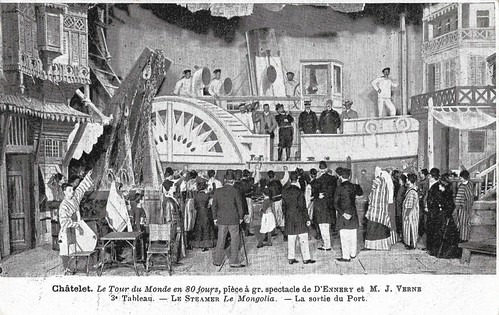
French postcard. Théâtre du Chatelet, Paris. 'Le Tour du Monde en 80 jours'. 3rd. tableau. 'Le Steamer le Mongolia - La sortie du port'. Play by Adolphe and D'Ennery and Jules Verne, after Verne's eponymous novel, written in 1873-1874, and first performed 7 November 1874 at the Théâtre de la Porte-Saint-Martin in Paris. Despite the enormous investments, even a real elephant was involved, the play was a giant success. People were queuing around the block to see how one could travel the whole world in eighty days, and in the case of the play, within the time span of just a few hours. From 1874 to the start of WWII, the play was constantly restaged and with great success. The version of this card must date from the early 1900s, while the first staging at the Châtelet dates from 1887, where it remained a crowd-puller for years.

French postcard. Théâtre du Châtelet, Paris. Le Tour du Monde en 80 jours. 6th tableau. Les funerailles d'un rajah.
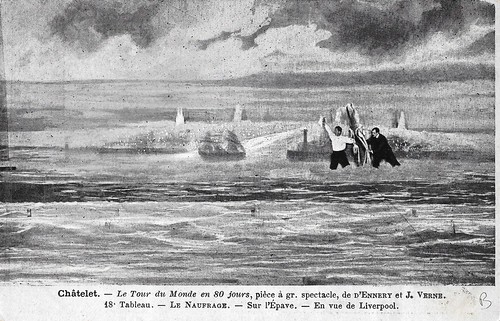
French postcard. Théâtre du Chatelet, Paris. Le Tour du Monde en 80 jours. 18th tableau. Le Naufrage - Sur l'Epave - En vue de Liverpool.
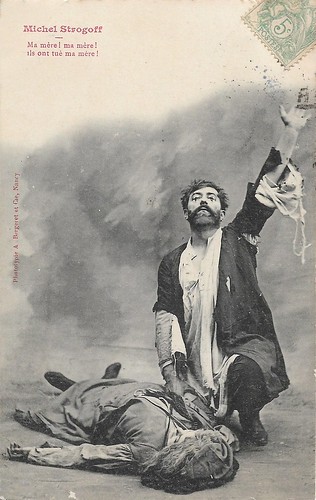
French postcard. Phototypie A. Bergeret et Cie., Nancy, 1900s. The setting may refer to a stage version but may simply also be staged for Bergeret's own interest. Around 1900 Jules Verne's 'Michel Strogoff' was one of the most popular adventure novels, set in 1860s Imperial Russia. In the 20th century, several film adaptations would be made in France, Germany, and elsewhere. Caption: My mother! My mother! They killed my mother!
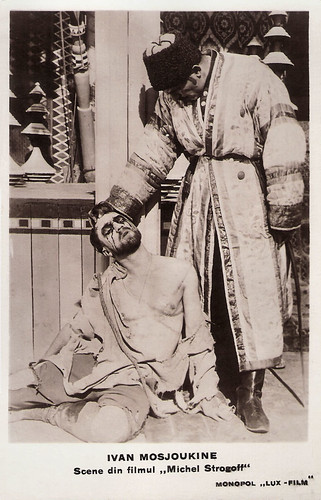
Romanian postcard by Editura Librariei SOCEC & Co. S.A., Bucuresti. Photo: Monopol "Lux-Film". Ivan Mozzhukhin in Michel Strogoff (Victor Tourjansky, 1926).
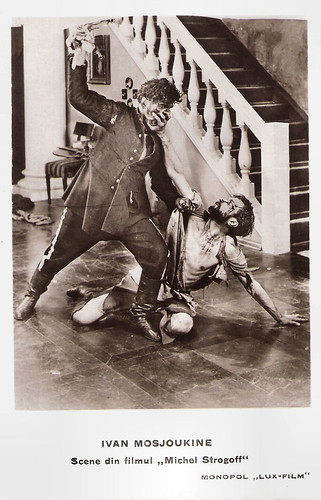
Romanian postcard by Editura Librariei SOCEC & Co. S.A., Bucuresti. Photo: Monopol "Lux-Film". Ivan Mozzhkukhin in Michel Strogoff (Victor Tourjansky, 1926).
Around the world in 80 days
Jules Verne had a Spartan way of working. He got up at five o'clock and worked on a book afterwards. In the afternoon, he could be found in a library documenting himself through books and magazines. In this way, he built up a collection of 20,000 fiche cards, from which he derived information for his stories. Verne had a technical interest, but his love was mainly for geography.
In 'Les enfants du capitaine Grant' (1867-1868; The Children of Captain Grant'), the geographer Jacques Paganel is the somewhat absent-minded but all-knowing companion of the travelling party that is searching for the lost captain through South America, Australia, and New Zealand. The interest in science and the belief in technical progress were great in the nineteenth century. There were plenty of travel journals, also from the century before.
'Le tour du monde en quatre-vingts jours' (1873; Around the world in 80 days) has been Verne's most successful novel, later also through film adaptations. By the time of his life, half a million copies had been sold. It first appeared as a serial in Le temps. Verne derived the itinerary from a magazine article and from a book about a trip around the world, published shortly before by William Perry Fogg, whom we know as the enterprising traveller Phileas Fogg from the story.
Even more lucrative than the fame he achieved with this were the revenues from putting the story on stage in a grand spectacle with real elephants on the stage, which became an enormous success. France began to become familiar with the concept of submarines. At the 1867 World's Fair in Paris, a model of 'Le Plongeur' (the diver) was on display, on which the illustrator of '20,000 Miles Under the Sea' based his work. The vessel operated on compressed air and proved very impractical. The nature of the deep sea could be studied in books and articles.
While writing, Verne discovered a follow-up story in the newspaper Le Petit Journal about a journey in a small submarine powered by electricity. It had been written by a member of the Amiens Scientific Academy, Verne's hometown. That Verne did not always test his imagination against reality is shown in the description of the submarine Nautilus. In the illustrations, the vessel appears narrow and closed, while inside there appear to be large spaces for a library, a dining room, and a large round window offering a view of the deep sea. Scientists, mostly stubborn and described with humour, are part of the crew and travelling companions. On the other hand, there is the engineer, a know-it-all, but often an inscrutable and fearsome man. Like Captain Nemo, inventor and pilot of the Nautilus, and Robur, skipper of the electricity-powered airplane the Albatross. This streamlined zeppelin-like airship has rows of propeller masts on its upper deck, powered by an electric motor.
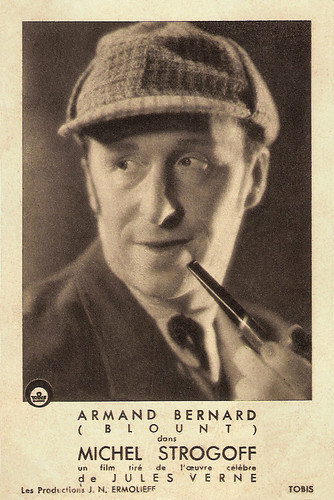
French postcard by Tobis. Photo: Les productions J.N. Ermolieff. Armand Bernard played the British correspondent Blount in Michel Strogoff (Jacques de Baroncelli, Richard Eichberg, 1936).
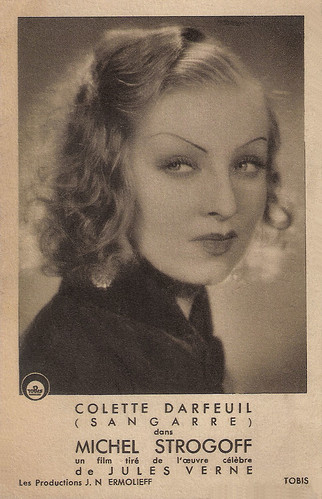
French postcard. Colette Darfeuil as the evil Sangarre, who plots together with Ivan Ogareff (Charles Vanel) in the French sound film Michel Strogoff (Jacques de Baroncelli & Richard Eichberg, Les productions J.N. Ermoliev / Tobis, 1936). Postcard for the showing of the film at the Paris cinema Marivaux. Adaptation of the famous novel by Jules Verne.

French postcard. Photo: Tobis / Les Productions J.N. Ermolieff. Charles Vanel as Ogareff in Michel Strogoff (Jacques de Baroncelli, 1936).
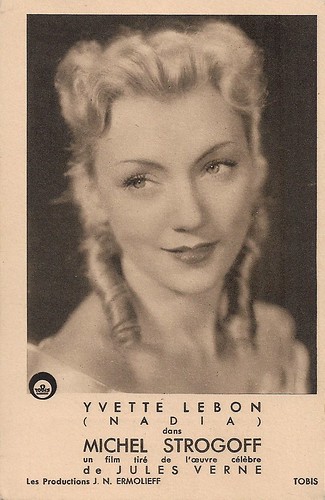
French postcard. Photo: Les productions J.N. Ermoliev / Tobis. Yvette Lebon as Nadia in the French sound film Michel Strogoff (Jacques de Baroncelli, Richard Eichberg, 1936). Caption: A film based on the famous novel by Jules Verne. On the back: shown at the Cinema Stanislas, between Thursday 8 and Monday 12 October. Nancy had a Cinema Stanislas (opened in 1925), but e.g. also Lunéville had one. Thursday 8 October refers to the year 1936, the year the film was released. The film premiered in Paris on 10 March 1936.

French postcard. Photo: Les productions J.N. Ermoliev / Tobis. Charpin as Jolivet in the French sound film Michel Strogoff (Jacques de Baroncelli, Richard Eichberg, 1936). Caption: A film based on the famous novel by Jules Verne.
The mysterious island
Not all Jules Verne books have a geographical exploration as their subject. A well-known type of novel is the so-called Robinsonade. Adults or boys end up on an island, where they try to build an existence with the available resources and their knowledge like Robinson Crusoe did. Examples are 'L'Île mystérieuse' (1873-1875: The mysterious island) and 'Deux ans de vacances' (1886-1887; Two Years' Vacation). The latter is a story written for children. Also 'Un capitaine de quinze ans' (1877-1878; A Captain of Fifteen), in which the young hero embarks on an adventurous journey on a twisted compass, can be counted among these.
In other stories by Verne, the events take place against the background of a historical event, a ghost story or a love story. A novel with a political meaning is 'Les cinq cents millions de la Bégum' (1879; Eldorado and the Monster Cannon of Steel City). In it, the inhabitants of a peaceful new French town are confronted with the threat of a new German town, entirely devoted to steel production. The enormous cannon, a predecessor of the Dicke Bertha from World War I, is both the symbol and the open danger. The Franco-German conflict after the war of 1870-1871 is clearly the background to this story.
A book with a patriotic slant and with a warning is 'Face au drapeau' (1896; Facing the Flag) The story focuses on a new enormous explosive mélinite, invented by the French Eugène Turpin. The latter figures here as the mad inventor Thomas Roch. The publisher and writer were sued by Turpin, which they won, assisted by the well-known French lawyer and statesman Raymond Poincaré. The work 'Paris in the 20th century', from Verne's early years, also contains a sharp critique of an over-engineered technical society. However, the melodramatic and satirical story was unbalanced.
Publisher Hetzel, therefore, did not wish to publish the manuscript, a decision to which Verne agreed. It was not until the 1990s that the text was found again and published. Verne is best known as the writer who "predicted the future". In his books, he described many things that were considered fantasy at the time, but later became reality in an impressive number of cases. He foresaw a journey to the moon that was first realised just over 100 years later during the Apollo programme. But there are also essential differences between this book and space travel.
Jules Verne's moon travellers, for example, are shot with a giant cannon and not launched with a rocket. The moon travellers do not land on the moon either but fly around it and then return, something that would happen later in the Apollo programme with Apollo 8 (1968, planned) and Apollo 13 (1970, unplanned, after an explosion on board). It is noteworthy that the launch site was also at Cape Canaveral and the place where Apollo 11 came down to earth was only a few kilometres different from the bullet in Verne's book.
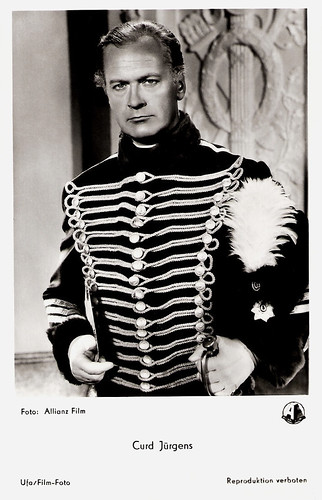
German postcard by Ufa, Berlin-Tempelhof, no. FK 3413. Photo: Allianz Film. Curd Jürgens in Michel Strogoff/Michael Strogoff (Carmine Gallone, 1956).

Dutch postcard by Uitgeverij Takken, Utrecht, no. AX 4213. Photo: 20th Century Fox. Pat Boone in Journey to the Center of the Earth (Henri Levin, 1959).

Spanish postcard by Postal Oscarcolor, no. 481. Photo: Jean Rochefort, Ursula Andress and Jean-Paul Belmondo in Les tribulations d'un Chinois en Chine/Up to His Ears (Philippe de Broca, 1965), based on the novel by Jules Verne from 1878.
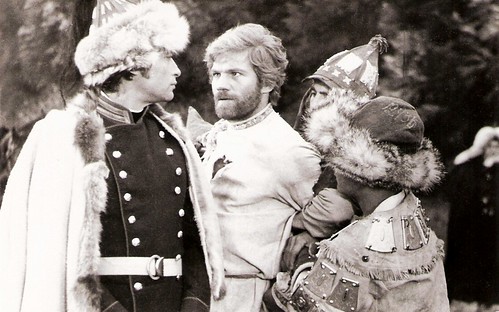
Vintage postcard. German actor Raimund Harmstorf (1939-1998) became famous as the protagonist in the German TV series Michael Strogoff: Der Kurier des Zaren/Michel Strogoff (1975), based on Jules Verne's adventure novel. Harmstorf was unforgettable as the handsome hero with a secret mission in an old Russia threatened by Kozaks and frozen rivers, wearing woolly hats and serious faces.
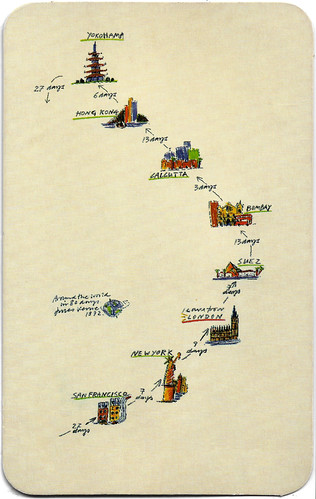
Italian postcard by Keep Moving in the Travel Card series, no. 1. Caption: Jules Verne (1828-1905), Round the world in 80 days (1873).

Dutch postcard by Young Media Group. Image: Walden Media / Independent Films. Poster for Around the World in 80 Days (Frank Coraci, 2004) with Jackie Chan, Steve Coogan and Cécile de France was based on the novel by Jules Verne.
Sources: Wikipedia (Dutch) and IMDb.
No comments:
Post a Comment